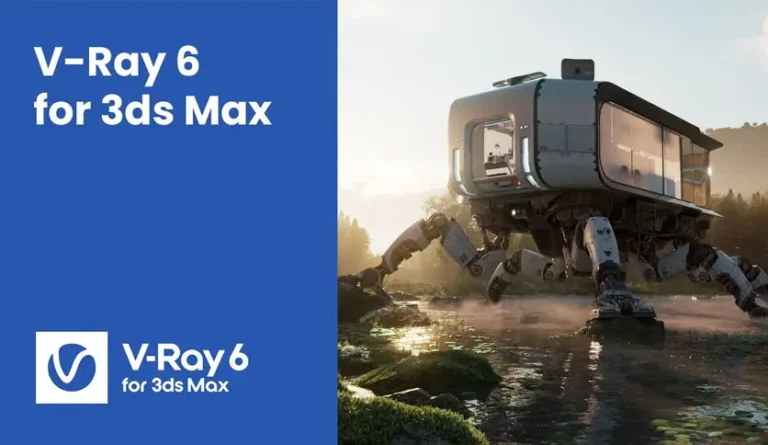Chaos has unveiled V-Ray 2026, setting a new standard in the world of 3D rendering and visualization. This landmark release introduces groundbreaking technologies that dramatically enhance both rendering quality and workflow efficiency, cementing V-Ray’s position as the industry-leading rendering solution for architecture, design, VFX, and beyond.
AI-Powered Material System
V-Ray 2026 introduces an intelligent material creation system that leverages machine learning to revolutionize material workflow. The AI Material Engine can generate physically accurate materials from simple reference images or even text descriptions, dramatically reducing the time needed to create complex materials.
“Our new AI Material Engine represents years of research into how materials interact with light in the physical world,” explains Dr. Elena Petrova, Lead Research Scientist at Chaos. “The system can identify complex material properties from a single reference image and generate a complete physically-based material with appropriate subsurface scattering, displacement, and microscale details.”
Key features of the new AI Material System include:
- Material generation from reference images or text descriptions
- Automatic material property extraction and creation
- Smart material variations with consistent physical properties
- Built-in library of over 5,000 AI-analyzed real-world materials
Real-Time Path Tracing
V-Ray 2026 brings a revolutionary real-time path tracing engine that delivers near-final quality results during the design process. This hybrid rendering solution combines the speed of rasterization with the accuracy of path tracing to provide interactive feedback with physically accurate lighting, reflections, and global illumination.
The new Real-Time Path Tracing engine offers:
- Interactive physically-based rendering at design time
- Progressive quality refinement from preview to production quality
- AI-enhanced denoising that preserves fine details
- Seamless transition between real-time and production rendering
- Compatible with all major design applications in the V-Ray ecosystem
Unified Lighting System
V-Ray 2026 introduces a unified lighting framework that brings unprecedented control and physical accuracy to all light types. The new system ensures consistent behavior across emissive materials, IES profiles, HDR environments, and traditional light sources, while adding powerful new artistic controls.
The Unified Lighting System includes:
- Physically accurate light falloff for all light types
- Advanced light mixing and filtering capabilities
- Interactive light painting for direct artistic control
- Physical light units with real-world intensity mapping
- Enhanced IES profile support with visual preview
Enhanced Cloud Rendering
V-Ray Cloud receives a major upgrade in the 2026 release, with significant improvements in rendering speed, cost efficiency, and workflow integration. The new distributed rendering system can intelligently allocate resources based on project needs and budget constraints.
Cloud rendering enhancements include:
- Hybrid local-cloud rendering with seamless resource balancing
- Auto-scaling rendering farms that optimize for time or budget
- Background asset synchronization for minimal upload times
- Pay-per-use pricing with predictive cost analysis
- Secure collaboration features for multi-studio projects
Procedural Environment Ecosystem
V-Ray 2026 introduces an advanced procedural environment system that allows artists to create and modify entire ecosystems with minimal effort. The system includes sophisticated procedural generators for vegetation, terrain, weather conditions, and atmospheric effects.
The Procedural Environment Ecosystem offers:
- Climate-based vegetation distribution with seasonal variations
- Procedural terrain generation with erosion simulation
- Dynamic weather system with physically accurate atmospheric rendering
- Time-of-day and seasonal lighting variations
- One-click environment population with context-aware placement
AI-Driven Post-Processing
V-Ray 2026 features a comprehensive AI-powered post-processing system that can enhance rendered images while maintaining physical accuracy. The intelligent filters can improve detail, remove noise, and adjust lighting without the artifacts commonly associated with traditional post-processing techniques.
The AI Post-Processing suite includes:
- Intelligent exposure adjustment that preserves highlight and shadow detail
- Content-aware depth of field with bokeh simulation
- Adaptive denoising that preserves fine texture details
- Style transfer capabilities for artistic interpretations
- Non-destructive workflow with real-time preview
Advanced Multi-GPU Acceleration
V-Ray 2026 takes full advantage of multi-GPU systems with a new rendering architecture optimized for the latest hardware. The engine can now distribute workloads across heterogeneous GPU setups, combining the power of different GPU generations and even mixing AMD and NVIDIA hardware.
Multi-GPU enhancements include:
- Dynamic workload distribution based on individual GPU capabilities
- Memory pooling across multiple GPUs for handling massive scenes
- Mixed-vendor GPU support (NVIDIA, AMD, and Intel)
- Out-of-core geometry handling for scenes larger than GPU memory
- Progressive rendering with quality-based hardware allocation
Enhanced Software Integration
V-Ray 2026 expands its ecosystem with improved integration across major 3D applications and introduces a new standalone application. The V-Ray Hub provides a central platform for managing assets, settings, and rendering across different host applications.
Integration enhancements include:
- Universal material and light presets that work across all platforms
- Advanced asset management with version control
- Streamlined workflow between Chaos products (V-Ray, Corona, Phoenix)
- Enhanced bridge to real-time engines (Unreal Engine, Unity)
- New V-Ray Hub standalone application for centralized management
Be Among the First to Experience V-Ray 2026
Join our priority access program and transform your rendering workflow with the most powerful version of V-Ray ever created.
Request Early AccessConclusion
V-Ray 2026 represents the most significant update to the rendering engine in its history. By embracing AI technology, real-time rendering, and cloud computing, Chaos has created a rendering solution that not only produces stunning images but also transforms the entire creative process for artists and designers.
The software will be available starting July 2026, with early access programs beginning in May for existing subscription customers. For more information on pricing and system requirements, visit the official Chaos website.
Join us to explore our V-Ray 2026 Course, featuring the most advanced version of this industry-leading rendering solution. This comprehensive program is designed to help 3D artists, architects, and visualization specialists master cutting-edge features like AI-powered material creation, real-time ray tracing, automated lighting optimization, and photorealistic environment simulation. Whether you’re rendering architectural visualizations, product designs, visual effects, or virtual environments, you’ll learn how to optimize your imaging workflow using intelligent tools that enhance visual fidelity, reduce render times, and improve creative exploration across complex projects. With professional-grade examples and hands-on training, this course ensures you’re fully equipped to harness the power of V-Ray 2026 and create stunning photorealistic imagery that pushes the boundaries of digital visualization while maintaining efficient production pipelines.





